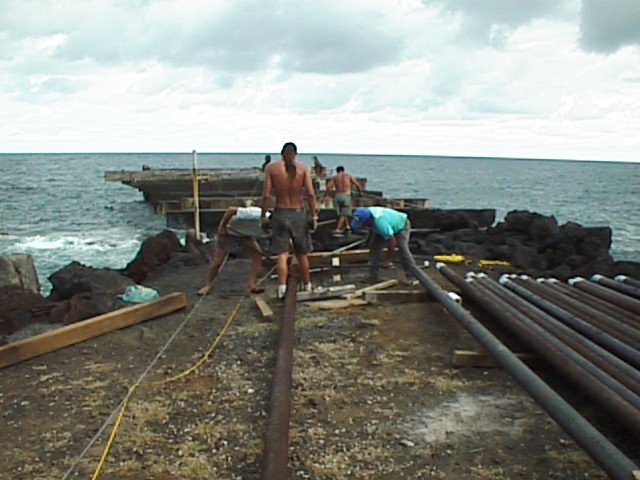 |
| Honu'apo pier has no solid top (visit our History of Honu'apo Pier page to learn why), so a walkway was constructed to enable the HUGO team to walk more easily between concrete pilings. To construct the walkway, hundreds of feet of pipe had to be laid along the pier. These pipes are seen in the image to the right. |
 |
|
| The walkway over the pier. Four by six foot pieces of plywood were laid over the pipes, creating a stable, if not altogether comfortable, means of negotiating the pier. The surf at Honu'apo is frequently very rough, making the walk along the pier less than relaxing. |
 |
|
| One of the major challenges in constructing the shore station was to install the hook-shaped iron pipe shown in the figure to the right. The pipe was installed off the end of the pier as shown in the figure below. To get the pipe down the walkway, the shore team constructed a sled from wooden beams and used a winch to drag it down the walkway. Here, shore station manager Bob Jordan shows off his sled-building prowess. |
 |
|
| Installing the pipe required the help of research divers for the underwater work. In the figure to the right the large metal pipe has been put into place and is being secured by the divers and the shore station team.
|
 |
|
 |
Awaiting the ship. After weeks of preparation, the HUGO team watches the ship approach shore. On the walkway are metal pipes that would later house the cable where it comes on shore. |
 |
The ship arrives at Honu'apo. The HUGO team decorated the pier area with ti leaves (for good luck) and watched the ship move in closer to shore. The R/V Independence has dynamic positioning capability and is capable of moving directly sideways if need be. As a result, the ship was able to come very close to the pier with little danger. |
| Reaching the ship. The original intent was to throw a rope to the ship to tie to the cable end. Later it was decided to bring the rope to the ship via a small boat. The rope was connected to a cable which ran through the long pipes. Thus by pulling on the rope on the shore end of the pipe, the entire cable could be hauled in. |

| |
 |
The vault. The rope that was brought to the ship was then connected to the fiber optic cable such that the entire cable could be winched along the sea floor, through the pipes which lie along the pier and finally underground to the underground vault, shown here. |
| Winching!. Winching the cable over hundreds of feet of sea floor and through the pipe took over two hours of hard cranking. The HUGO team's spirits were kept up by a local crowd of onlookers. |

| |
 |
Victory! After years of designing and building, weeks of final preparations and hours of hauling on the cable, the heavily armored cable is pulled into the vault. From here, the cable was spliced to another optical cable which connects the submarine cable to the shore station. |
 |
Another view of the heavily armored cable (the armor is to protect the cable from pounding due to heavy surf in the shallow waters near Honu'apo). Several extra meters were brought on land so that the fiber optic cable could be spliced onto the cable which leads underground from the vault to the data collection vans. |



